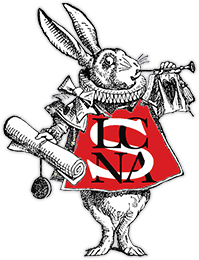Carroll Centenary Articles
This page contains two sample of articles that were written about or for the Lewis Carroll Centenary. There were, of course, many, many more around the world. If you know of a particularly good one, please e-mail a copy to us!
- An article by Dawn Comer on the centenary that appeared in the Niles Daily Star on January 3. A view of the centenary from the heartland (Michigan):
Lewis Carroll Centenary Article
Niles Daily Star January 3, 1998
Niles, MI
Dawn Comer (ghostwritten for Todd Comer)
One hundred years ago on January 14, a delightful genius died. Who, you may ask? Charles Lutwidge Dodgson, mathematician, logician, accomplished photographer, and clergyman. Recognize him? No? Perhaps this will help. Dodgson’s pen name was Lewis Carroll, most famous for Alice’s Adventures in Wonderland and Through the Looking Glass, works quoted second only to the Bible.
Why should we care? To begin with, Lewis Carroll changed the way we view children’s literature. Imagine the poor Victorian children who were subjected to books written solely for the purpose of instilling pious morals, stories Carroll humorously refers to in Adventures: “for she (Alice) had read several nice little stories about children who had got burnt, and eaten up by wild beasts, and other unpleasant things, all because they would not remember the simple rules their friends had taught them.” Carroll’s Alice books were influential precisely because he turned Victorian moralism on its head. He parodied popular poems and songs, such as Isaac Watts’ Against Idleness and Mischief which Alice attempts to quote in Wonderland but which comes out all wrong in the humorous verse, How doth the little crocodile. Now I have nothing against teaching morals. Believe me, I think children should grow up well-grounded in morality. But who says children can’t have fun?
In today’s society children often grow up too fast. Sometimes out of necessity to cope with harsh realities of their environment. Sometimes out of parents’ well-meant intentions for academic and creative success ridiculous things like intensively training preschoolers to learn a musical instrument or foreign language. When it comes to books, we have fallen into the trap of the Victorians. Most children’s books speak down to children, moralize to them, attempt to teach too much too soon often for the sake of political correctness.
They forsake the imagination for more of reality, or use imagination as a tool valuable only insofar as it can teach. Children need to go with Alice to an unbirthday party with the Mad Hatter and March Hare. They need to go Where the Wild Things Are with Maurice Sendak’s child-hero, Max. They need to see unbelievable things with Marco on Seuss’ Mulberry Street or spend a rainy afternoon with the Cat in the Hat. Children even need to float across the ocean in a giant peach with a boy named James and a handful of insects and not through the film either. The book is much better, fully exhibiting Roald Dahl’s wit without attempting to moralize.
So Lewis Carroll gave us a model for children’s literature. What else did he give us? He gave us an example of what it means to be a friend to a child. Throughout his life, Lewis Carroll suffered from a debilitating stutter, a stutter which disappeared in the presence of children. Around adults he was often shy and withdrawn. With children he could be himself, creating stories, demonstrating invented toys like Bob the Bat which lived in the top left drawer of his writing desk, and taking photographs. His most influential child friendship was formed with Alice Liddell, daughter of the Dean of Christ Church at Oxford. In fact, Alice’s Adventures originated after a boat ride with Alice and her sisters, Lorina, and Edith, and a Christ Church colleague. The first Alice book was born when Alice pleaded with Carroll to write down the story they had all created. Whenever he traveled, Carroll carried a black bag filled with games and gadgets and copies of Alice which he liberally shared with child friends he made.
He didn’t forget his young friends but kept in contact through letters. He wrote picture-puzzle rebus letters, nonsense letters, looking-glass letters which had to be held in front of a mirror to be read. He never talked down to children but treated them as equals. He encouraged imagination and delighted in highly logical nonsense he never underestimated a child’s intelligence. Carroll let children be children.
We can learn a great deal through Carroll’s example who always made time for children, despite his many duties at Christ Church, Oxford. Yes, he was a fine mathematician and photographer, but the greatest testament to his life comes from the reminiscences of his child friends who wrote of him in consistently admirable terms. Lewis Carroll possessed a rare gift. Through the Alice stories, he opened the door to a Wonderland governed by absurd logic. Through his own childlike nature, he became an ideal friend to many a child. His legacy lives beyond the confines of children’s literature, studied by mathematicians, psychologists, and literary critics alike. But the charm of Alice remains in the history of its origins a tale created out of love for a child.
Dawn Comer- An article in El Correo Bilbao, Spain . This is the last of a series of articles dealing with the centenary. In Spanish:
Iñaki Uriarte


